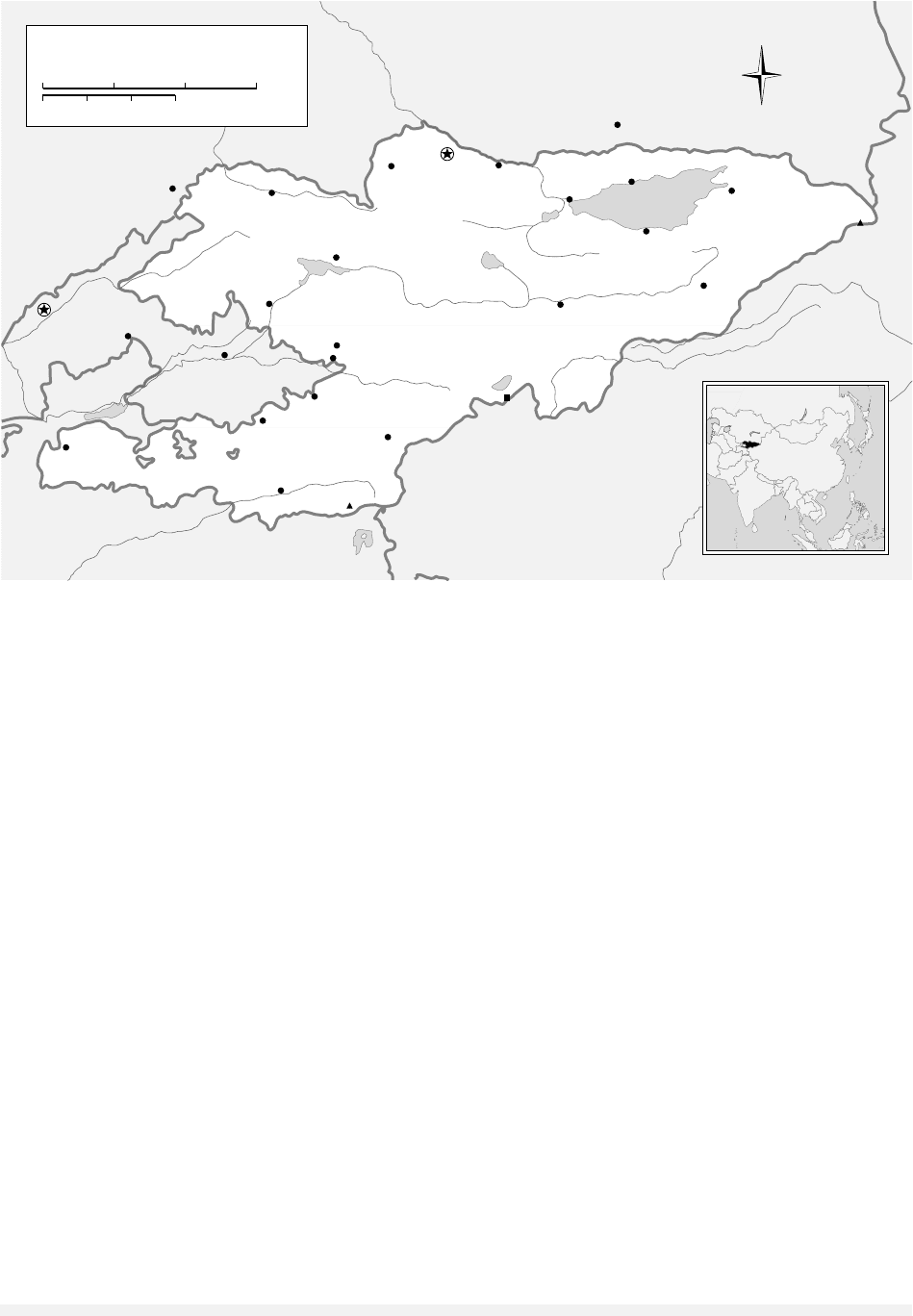Encyclopedia of Russian History
Подождите немного. Документ загружается.


mer-fall campaign, which by late September col-
lapsed the entire German front from Velikie Luki
to the Black Sea and propelled Red Army forces for-
ward to the Dnieper River. After Kursk the only
unresolved questions regarded the duration and fi-
nal cost of Red Army victory.
See also: WORLD WAR II
BIBLIOGRAPHY
Erickson, John. (1983). The Road to Berlin. Boulder, CO:
Westview Press .
Glantz, David M., and House, Jonathan M. (1999). The
Battle of Kursk. Lawrence: University Press of Kansas.
Glantz, David M., and Orenstein, Harold S, eds. (1999).
The Battle for Kursk 1943: The Soviet General Staff
Study. London: Frank Cass.
Manstein, Erich von. (1958). Lost Victories. Chicago:
Henry Regnery.
Zetterling Niklas, and Frankson, Anders. (2000). Kursk
1943: A Statistical Analysis. London: Frank Cass.
D
AVID
M. G
LANTZ
KURSK SUBMARINE DISASTER
On Saturday, August 12, 2000, the nuclear-
powered cruise-missile submarine Kursk (K-141),
one of Russia’s most modern submarines, was lost
with all 118 crewmembers during a large-scale ex-
ercise of the Russian Northern Fleet in the Barents
Sea. The Kursk sank just after its commander, Cap-
tain First Rank Gennady Lyachin, informed the ex-
ercise directors that the submarine was about to
execute a mock torpedo attack on a surface target.
Exercise controllers lost contact with the vessel
and fleet radio operators failed to reestablish com-
munication. Shortly after the Kursk’s last com-
munication, Russian and Western acoustic sensors
recorded two underwater explosions, one smaller
and a second larger (the equivalent of five tons of
TNT).
Russian surface and air units began a search
for the submarine and in the early evening located
a target at a depth of 108 meters (354.3 feet) and
about 150 kilometers (93 miles) from the North-
ern Fleet’s base at Murmansk. Russian undersea
rescue units were dispatched to the site. The com-
mand of the Northern Fleet was slow to announce
the possible loss of the submarine or to provide re-
liable information on the event. On August 13
Admiral Vyacheslav Popov, commander of the
Northern Fleet, conducted a press conference on the
success of the exercise but did not mention the pos-
sible loss of the Kursk. A Russian undersea appa-
ratus reached the Kursk on Sunday afternoon and
reported that the submarine’s bow had been se-
verely damaged by an explosion. The rescue crews
suggested three hypotheses to explain the sinking:
an internal explosion connected with the torpedo
firing, a possible collision with another submarine
or surface ship, or the detonation of a mine left
over from World War II.
On Monday, August 14, the Northern Fleet’s
press service began to report its version of the dis-
aster. The reports emphasized the absence of nu-
clear weapons, the stability of the submarine’s
reactors, and the low radioactivity at the site. It
also falsely reported that communications had been
reestablished with the submarine. The Northern
Fleet and the Naval High Command in Moscow re-
ported the probable cause of the disaster as a col-
lision with a foreign submarine. While there were
reports of evidence supporting this thesis, none was
ever presented to confirm the explanation, and both
the United States and Royal navies denied that any
of their submarines had been involved in any col-
lision with the Kursk. The Russian Navy was also
reluctant to publish a list of those on board the
submarine. The list, leaked to the newspaper Kom-
somolskaya pravda (Komsomol Truth), was pub-
lished on August 18. The Russian Navy’s initial
unwillingness to accept foreign assistance in the
rescue operation and failure to get access to the
Kursk undermined its credibility.
When President Vladimir Putin learned of the
crisis while on vacation in Sochi, he created a State
Commission under Deputy Prime Minister Ilya Kle-
banov to investigate the event. Putin invited for-
eign assistance in the rescue operation. British and
Norwegian divers successfully entered the Kursk on
August 21 and found no survivors. Putin had kept
a low profile during the rescue phase and did not
directly address the relatives of the crew until Au-
gust 22. At that time Putin vowed to recover the
crew and vessel. In the fall of 2001 an international
recovery team lifted the Kursk, minus the damaged
bow. The hull was brought back to a dry dock at
Roslyakovo. In December 2001, on the basis of in-
formation regarding the preparation for the exer-
cise in which the Kursk was lost, President Putin
fired fourteen senior naval officials, including Ad-
miral Popov. Preliminary data from the Klebanov
KURSK SUBMARINE DISASTER
803
ENCYCLOPEDIA OF RUSSIAN HISTORY

commission seems to confirm that the submarine
sank as a result of a detonation of an ultra high-
speed torpedo, skval-type. On June 18, 2002, Ilya
Klebanov confirmed that the remaining plausible
explanation for the destruction of the submarine
was an internal torpedo explosion.
See also: MILITARY, SOVIET AND POST-SOVIET; PUTIN,
VLADIMIR VLADIMIROVICH
BIBLIOGRAPHY
Burleson, Clyde. (2002). Kursk Down. New York: Warner
Books.
J
ACOB
W. K
IPP
KUSTAR
Cottage worker, home worker; a peasant engaged
in cottage industry (kustarnaya promyshlennost) to
earn cash, usually in combination with agricultural
production.
Cottage industry became an important source
of income for rural peasants in some parts of Rus-
sia by the sixteenth century and developed exten-
sively during the nineteenth century, producing a
wide range of wooden, textile, metal, and leather
goods. It was usually a family enterprise, although
some peasants formed producer cooperatives and
worked under the supervision of an elected elder.
Some cottage workers independently produced and
sold their production, while others participated in
a putting-out system in which they worked for a
middleman who furnished them with raw or semi-
finished materials and collected and marketed the
finished products. By the beginning of the twenti-
eth century, the state, zemstvos, and cooperatives
had established schools, credit banks, and ware-
houses to assist cottage workers in producing and
marketing a wide variety of goods.
The socioeconomic position of Russian cottage
workers was the subject of many debates in the
decades preceding the revolution. Populists argued
that most cottage workers remained peasant agri-
culturists and engaged in cottage industry only to
supplement their earnings from agriculture, while
Marxists contended that cottage workers were be-
coming proletarianized and wholly dependent on
the income they earned from selling manufactured
goods to middlemen.
Despite increasing competition from factories,
cottage industry continued to account for a large
share of Russian manufactured goods until the end
of the tsarist regime, and enjoyed a brief revival
in the 1920s under the New Economic Policy.
Notwithstanding the importance of cottage indus-
try in the Russian economy, there is no reliable data
for the number of cottage workers in the country
as a whole. Estimates range from 2.5 million to 15
million peasants engaged in cottage industry at the
end of the nineteenth century.
See also: PEASANT ECONOMY; PEASANTRY
BIBLIOGRAPHY
Blum, Jerome. (1961). Lord and Peasant in Russia from
the Ninth to the Nineteenth Century. Princeton, NJ:
Princeton University Press.
Crisp, Olga. (1976). Studies in the Russian Economy Before
1914. London: Macmillan.
Gatrell, Peter. (1986). The Tsarist Economy, 1850–1914.
London: Batsford.
Salmond, Wendy R. (1996). Arts and Crafts in Imperial
Russia: Reviving the Kustar Art Industries, 1970–1917.
Cambridge, UK: Cambridge University Press.
E. A
NTHONY
S
WIFT
KUTUZOV, MIKHAIL ILARIONOVICH
(1745–1813), general, renowned for his victory
over Napoleon.
At the age of sixty-seven, Mikhail Kutuzov led
the Russian armies to victory over Napoleon in the
War of 1812 and created the preconditions for their
final victory in the campaigns of 1813 and 1814.
Kutuzov first distinguished himself in extensive
service against the Turks during the reign of
Catherine II. He served in the Russo-Turkish War
of 1768–1774, first on the staff of Petr Rumyant-
sev’s army, and then in line units with Vasily Dol-
gorukov’s Crimean Army. In combat in the Crimea
in 1774 he was shot through the head and lost an
eye. When he returned to service, he took com-
mand of the Bug Light Infantry Corps of Field Mar-
shal Alexander Suvorov’s army. He led his corps
into combat with the Turks once again when war
broke out in 1788. He was wounded again at the
siege of Ochakov in that year, but continued to
command troops throughout the war, serving un-
der Grigory Potemkin and Alexander Suvorov. Fol-
KUSTAR
804
ENCYCLOPEDIA OF RUSSIAN HISTORY

lowing the end of hostilities, Kutuzov served in a
number of senior positions, including ambassador
to Turkey, commander of Russian forces in Fin-
land, and military governor of Lithuania. It seemed
that his days as an active commander had passed.
In September 1801 he retired.
The Napoleonic Wars put a quick end to Ku-
tuzov’s ease. When war threatened in 1805,
Alexander I designated Kutuzov, now a field mar-
shal, commander of the leading Russian expedi-
tionary army sent to cooperate with the Austrians.
On the way to the designated rallying point of
Braunau, on the Austrian border with Bavaria, Ku-
tuzov learned of the surrender of the Austrian
army at Ulm on October 20. Now facing French
forces four times stronger than his army, Kutuzov
began a skillful and orderly withdrawal to the east,
hoping to link up with reinforcements on their way
from Russia. Desperate rearguard actions made
possible this retreat, which included even a brief
victory over one of Napoleon’s exposed corps at the
Battle of Dürnstein. Despite Napoleon’s best efforts,
Kutuzov managed to withdraw his army and link
up with reinforcements, headed by the tsar him-
self, at Olmütz in Moravia in late November. Fooled
into thinking that Napoleon was weak, Alexander
overruled the more cautious Kutuzov repeatedly in
the days that followed, ordering the field marshal
to launch an ill-advised attack on the French at
Austerlitz on December 2. Wounded once again
while trying to rally his men to hold a critical po-
sition, Kutuzov helped Alexander salvage what
could be saved from the wreckage, and then com-
manded the army during its retreat back to Russ-
ian Poland.
Blaming Kutuzov for his own mistakes,
Alexander relegated Kutuzov to the post of mili-
tary governor general of Kiev. It was not long be-
fore Kutuzov returned to battle, however, for he
joined the Army of Moldavia in 1808 and com-
manded large units in the war against the Turks
(1806–1812). In 1809 he was relieved once more
and sent to serve as governor general of Lithuania,
but in 1811 Alexander designated Kutuzov as the
commander of the Russian army fighting the
Turks. In the shadow of the impending Franco-
Russian war, Kutuzov waged a skillful campaign
that resulted in the Peace of Bucharest bare weeks
before the French invasion began.
The War of 1812 was Kutuzov’s greatest cam-
paign. Alexander relieved Mikhail Barclay de Tolly
after his retreat from Smolensk and appointed Ku-
tuzov, hoping thereby to see a more active resis-
tance to the French onslaught. Kutuzov, however,
continued Barclay de Tolly’s program of retreating
in the face of superior French numbers, until he
stood to battle at Borodino. Following that com-
bat, Kutuzov continued his withdrawal, eventually
abandoning Moscow and retreating to the south.
He defeated Napoleon’s attempt to break out to the
richer pastures of Ukraine at the Battle of Malo-
yaroslavets, and then harried the retreating French
forces all the way to the Russian frontier and be-
yond. He died on April 28, 1813, a few weeks af-
ter having been relieved of command of the Russian
armies for the last time.
See also: ALEXANDER I; AUSTERLITZ, BATTLE OF;
BORODINO, BATTLE OF; BUCHAREST, TREATY OF;
FRENCH WAR OF 1812; MILITARY, IMPERIAL ERA;
NAPOLEON I; RUSSO-TURKISH WARS
BIBLIOGRAPHY
Parkinson, Roger. (1976). The Fox of the North: The Life of
Kutuzov, General of War and Peace. London: P. Davies.
F
REDERICK
W. K
AGAN
KUYBYSHEV, VALERIAN VLADIMIROVICH
(1888–1935), Bolshevik, politician, Stalinist, active in
civil war and subsequent industrialization initiatives.
Active in the Social Democratic Party from
1904, Valerian Kuybyshev was an Old Bolshevik
who played a major role in the Russian Civil War
as a political commissar with the Red Army. Hav-
ing fought on the Eastern Front against the forces
of Admiral Kolchak, he was instrumental in con-
solidating Soviet power in Central Asia following
the civil war. Kuybyshev subsequently held several
important political posts: chairman of the Central
Control Commission (1923); chairman of the
Supreme Council of the Soviet Economy (1926);
member of the Politburo (1927); chairman of Gos-
plan (1930); and deputy chairman of both the
Council of People’s Commissars and Council of La-
bor and Defense (1930).
A staunch Stalinist throughout the 1920s,
Kuybyshev advocated rapid industrialization and
supported Stalin in the struggle against the Right
Opposition headed by Nikolai Bukharin. Kuyby-
shev’s organizational skills and boundless energy
were critical in launching the First Five-Year Plan
KUYBYSHEV, VALERIAN VLADIMIROVICH
805
ENCYCLOPEDIA OF RUSSIAN HISTORY

in 1928. However, in the early 1930s Kuybyshev
became associated with a moderate bloc in the Polit-
buro who opposed some of Stalin’s more repres-
sive political policies.
Kuybyshev died suddenly on January 26,
1935, ostensibly of a heart attack, but there is some
speculation that he may have been murdered by
willful medical mistreatment on the orders of Gen-
rich Yagoda—an early purge following the assas-
sination of Sergei Kirov. Whatever the actual
circumstances of his death, he was given a state
funeral, and the city of Samara was renamed in his
honor.
See also: CIVIL WAR OF 1917–1922; INDUSTRIALIZATION,
RAPID; RED ARMY; RIGHT OPPOSITION; STALIN, JOSEF
VISSARIONOVICH.
BIBLIOGRAPHY
Conquest, Robert. (1990). The Great Terror: A Reassess-
ment. New York: Oxford University Press.
Kuibyshev, V. V. (1935). Personal Recollections. Moscow.
K
ATE
T
RANSCHEL
KUZNETSOV, NIKOLAI GERASIMOVICH
(1904–1974), commissar of the navy and admiral
of the fleet of the Soviet Union.
A native of the Vologda area, from a peasant
background, Kuznetsov was born on July 11,
1904. He joined the Red Navy in 1919, served dur-
ing the civil war with North Dvina Flotilia, and
fought against the Allied Expeditionary Force and
the Whites. He served in the Black Sea Fleet begin-
ning in 1921, became a Communist Party member
in 1925, and graduated from the Frunze Naval
School in 1926 and the naval Academy in 1932.
He served as assistant commander of the cruiser
Krasnyi Kavkaz (1932–1934), and as commander
of the cruiser Chervona Ukraina (1934–1936).
Kuznetsov served as naval attaché in Spain and was
the Soviet advisor to the Republican Navy during
the Spanish Civil War from 1936 to 1937. After
returning from Spain, he served as the first deputy
commander of the Pacific Fleet (commissioned Au-
gust 15, 1937) and as commander of the Pacific
Fleet from 1938 to 1939.
Kuznetsov was recalled to Moscow in March
of 1939 and was appointed as the first deputy.
Days later, on March 12, 1939, he was appointed
commissar of the Navy. He held this position un-
til 1946, leading the Soviet Navy during World War
II with mixed results. The Navy did not perform
well against an enemy whose naval interests were
elsewhere, and it remained in a defensive mode for
most of the war, suffering heavily at the hands of
the Luftwaffe. The Soviet retreat from the Baltics
proved to be a fiasco, but the Navy performed bet-
ter in the evacuation of Odessa and Sevastopol. Two
landings in Kerch in 1942 and 1943 ended in dis-
aster, but the blame was not confined to the Navy.
The Volga Flotilla played a significant part in the
defense of Stalingrad, and the stationary Baltic Fleet
provided artillery support in the Battle of Leningrad.
Throughout 1944 and 1945, a number of landings
took place behind the enemy lines, which resulted
in little gain and heavy losses.
The outspoken Kuznetsov may have offended
Stalin, although he blamed the Navy’s shortcom-
ings on Andrei Alexandrovich Zhdanov, the polit-
ical commissar of the Navy before the war. In
February 1946, Stalin divided the Baltic and Pacific
Fleets into four separate units, a decision Kuznetsov
opposed. The end result was the removal of
Kuznetsov. He was forced to face a Court of Honor,
where several admirals were accused of passing
naval secrets to the Allies during the war.
Kuznetsov was reduced to the rank of rear admi-
ral on February 3, 1948, and was sent to the re-
serves, but was called back and appointed as deputy
commander in chief in the Far East for the Navy
on June 12, 1948. On February 20, 1950, he was
reappointed to his old job of commander of the Pa-
cific Fleet. Stalin, encouraged by Lavrenti Beria
(head of the secret police), also recalled him, and
once again named him commissar of the Navy on
July 20, 1951. He kept this position even after
Stalin’s death.
On the night of October 29, 1955, the Soviet
Navy suffered its greatest peacetime disaster when
the battleship Novorossisk blew up in Sevastopol,
with the loss of 603 lives. Kuznetsov was blamed
for this disaster, and was removed from his posi-
tion. On February 15, 1956, he was once again re-
duced in rank and forcibly retired. Kuznetsov’s
reputation was rehabilitated only in 1988, fourteen
years after his death and after a long campaign by
his widow. During his roller-coaster career, he was
rear admiral twice, vice admiral three times, and
admiral of the Fleet of the Soviet Union twice. He
was deputy to the Supreme Soviet three times, and
served the Eighteenth Party Congress in 1939. He
was also declared a Hero of the Soviet Union on
KUZNETSOV, NIKOLAI GERASIMOVICH
806
ENCYCLOPEDIA OF RUSSIAN HISTORY

September 14, 1945. The Soviet naval policy
changed after Kuznetsov, who was mainly a sur-
face-ship admiral, to emphasize an oceanic navy
that was heavily dependent on a large fleet of sub-
marines, missile cruisers, and even the occasional
aircraft carrier.
See also: BALTIC FLEET; BLACK SEA FLEET; MILITARY, IM-
PERIAL; PACIFIC FLEET
M
ICHAEL
P
ARRISH
KYRGYZSTAN AND KYRGYZ
The Kyrgyz are a nomadic people of Turkic descent
living in the northern Tien Shan mountain range.
Originally chronicled as living in the region of
what is today eastern Siberia and Mongolia, the
Kyrgyz migrated westward more than a thousand
years ago and settled in the mountains of Central
Asia. At the beginning of the twenty–first century,
ethnic Kyrgyz live in the countries of Kazakhstan,
China, Russia, Uzbekistan, and Tajikistan. The ma-
jority of the Kyrgyz live in the country of the Kyr-
gyz Republic (known as Kyrgystan), a former
republic of the Soviet Union that received its inde-
pendence in 1991 when the Soviet Union collapsed.
With an area of 76,000 square miles (198,500
square kilometers), the mountainous, landlocked
republic is nestled between Kazakhstan, China,
Tajikistan, and Uzbekistan. The Kyrgyz Republic’s
population is 4,822,166, of which 2,526,800
(52.4%) are ethnic Kyrgyz. Significant minority
groups include Russians (18%), Uzbeks (12.9 per-
cent), Ukrainians (2.5%), and Germans (2.4%). The
capital city of Bishkek has an estimated popula-
tion of 824,900, although the number may be
closer to one million if illegal immigrants are con-
sidered.
Sunni Islam of the Hanafi School is the dom-
inant faith among the Kyrgyz. However, when Is-
lam was introduced to the people, many kept their
indigenous beliefs and customs. The force of Is-
lam was further weakened during the Soviet pe-
riod when active religious adherence was
discouraged. During the early twenty-first cen-
tury, the Kyrgyz government espouses strong
support for maintaining a secular state and any
sympathy for radical Islam has been marginalized.
Linguistically, Kyrgyz is a Turkic language that
is mutually intelligible with Kazakh. Throughout
the past several centuries, it has been written in the
Arabic, Latin, and Cyrillic scripts, with the latter
two dominant during the Soviet period. The gov-
ernment is shifting the language back to the Latin
script, with an effort to emulate the Turkish model.
The early history of the Kyrgyz is shrouded in
mythology, particularly the founding legend of the
Manas, an epic poem of more than one million lines
that is still presented orally, through song. Kyrgyz
have had, in the past, their own forms of govern-
ment, although more often they have been under
the rule of outside forces: Mongol, Chinese,
Timurid, and Russian, to name the most signifi-
cant. During the period of the Russian Empire, the
Kyrgyz were often called Kara-Kyrgyz. There is a
common history with the Kazakhs, who were con-
fusingly called the Kyrgyz by Russian ethnogra-
phers for most of the nineteenth century. Although
they were incorporated into the Khanate of Kokand
in the eighteenth century, the Kyrgyz were not al-
ways content with being controlled by others. Kyr-
gyz clans rebelled four times between 1845 and
1873. When the Khanate of Kokand was incorpo-
rated into the Russian province of Semirech’e in
1876, the same ire was directed against the new
overlords.
Through the rest of the nineteenth century and
into the early twentieth century, the region of the
Kyrgyz was firmly entrenched in the Russian Em-
pire. In 1916, there was a large-scale uprising in
the region against the threat of drafting ethnic Kyr-
gyz and other Central Asians into the Russian
Army, to support the effort against Germany and
Austria-Hungary. The regional turmoil only deep-
ened with the Bolshevik Revolution of 1917 and the
subsequent civil war, both of which had direct ef-
fects on the Kyrgyz people. Significant fighting
took place on Kyrgyz soil, and the anti-Bolshevik
Basmachi Rebellion was partially based in the re-
gions of southern Kyrgyzstan, around the city of
Osh. By the early 1920s the region was pacified,
but at a high cost: Perhaps a third of all residents
of the region either died in the fighting and in the
famine that plagued Central Asia in those years, or
fled to China.
In the National Delimitation of 1924, the ter-
ritory of the Kyrgyz was incorporated in the
Kazakh Soviet Socialist Republic and was dubbed
an Autonomous Republic. The region was elevated
to full Union-Republic status in 1936 and was of-
ficially called the Kirgiz Soviet Socialist Republic
(Kir.S.S.R.). This entity lasted until 1991, when the
KYRGYZSTAN AND KYRGYZ
807
ENCYCLOPEDIA OF RUSSIAN HISTORY

Soviet Union was officially dissolved. At the time
of independence, the name was changed to the Re-
public of Kyrgyzstan, and later the Kyrgyz Re-
public. With independence, the former president of
the Kirgiz Soviet Socialist Republic, Askar Akayev,
was elected president of the new country. He con-
tinued to hold that position in 2003, and has con-
solidated his authority over the years. The Kyrgyz
Republic has the institutions associated with a
democracy—a legislature, a judiciary, a president,
and a constitution—but the conditions for demo-
cratic development remain weak.
Economically, the Kyrgyz have traditionally
been nomadic herders, and pastoral activity re-
mains important for the Kyrgyz. With more than
80 percent of the territory being mountainous, pas-
toral habits include bringing the herds to high-
elevation fields during the summer and back to the
valleys during the winter months. There are also
mineral deposits in the country, particularly of
gold and some strategic minerals that can be ex-
ploited. Overall, the economy remains poor, with
a gross national product (GDP) of approximately
$13.5 billion dollars. While the purchasing power
parity (PPP) of the country is $2,800 per capita,
typical incomes often fall to less than $100 per
month per person.
Making matters worse is the fact that the coun-
try has borrowed heavily from the international
community during the first decade of independence.
The national budget is actually exceeded by the
amount owed to organizations such as the World
Bank and the International Monetary Fund, totaling
more than $1.6 billion as of 2003. In addition, cor-
ruption is rampant and most international com-
panies and observers view the business conditions
in the country in a negative light. These problems
will continue to plague any effort at economic re-
form that the current government, or its successor,
might try to implement.
While there are ethnic Kyrgyz in neighboring
Uzbekistan, Kazakhstan, Tajikistan, and China, the
respective populations are relatively modest and do
not cause much concern. Regardless, the Kyrgyz feel
it necessary to establish positive relations with these
neighboring states, in large part because of the dif-
ficult borders and the fact that the Kyrgyz Republic
KYRGYZSTAN AND KYRGYZ
808
ENCYCLOPEDIA OF RUSSIAN HISTORY
Z
E
R
A
V
S
H
A
N
R
A
N
G
E
A
L
A
Y
S
K
I
Y
K
H
R
E
B
E
T
K
Y
R
G
Y
Z
S
K
I
Y
K
H
R
E
B
E
T
T
I
A
N
S
H
A
N
Jengish
Chokusu
24,406 ft.
7439 m.
Pik Lenina
23,406 ft.
7134 m.
Turugart
Pass
K
Ö
K
S
H
A
L
T
A
U
Issy-Kul'
(Ysyk-Köl)
Ozero
Song-Kël'
Ozero
Chatyr-Kël'
K
a
r
a
A
k
s
a
y
N
ary
n
S
h
u
T
a
l
a
s
K
y
z
y
l
C
h
i
r
c
h
i
k
Toxkan
Vakhsh
Ozero
Karakul'
¯
Kara-Balta
Jalal-Abad
Tash Kömür
Tokmak
Przheval'sk
Kara-Say
Sülüktü
Talas
Namangan
Daraut Kurgan
Angren
Kok Yangak
Toktogul
Kyzyl-Kyya
Gul'cha
Naryn
Cholpon-Ata
Issy-Kul'
(Ysyk-Köl)
Kadzhi
Say
Tyul'kubas
Bishkek
Alma-Ata
Tashkent
Osh
KAZAKHSTAN
TAJIKISTAN
UZBEKISTAN
CHINA
W
S
N
E
Kyrgyzstan
KYRGYZSTAN
150 Miles
0
0
150 Kilometers
50 100
50 100
Kyrgyzstan, 1992. © M
ARYLAND
C
ARTOGRAPHICS
. R
EPRINTED WITH PERMISSION

is a relatively small neighbor in this region. Thus, it
is not surprising to see the Kyrgyz government par-
ticipate in a number of multilateral security and trade
agreements. It is an active member of the Common-
wealth of Independent States, the Shanghai Cooper-
ation Organization (which includes China, Russia,
Tajikistan, Kazakhstan, and Uzbekistan), the Collec-
tive Security Agreement (with six CIS states), as well
as a number of regional initiatives. It is also a mem-
ber of the NATO Partnership for Peace Program and,
as a result of the U.S.-led Global War on Terrorism,
agreed to have NATO forces establish a military air-
base outside of the capital city Bishkek in 2001. Dur-
ing 2002, the Kyrgyz government allowed the
Russian Air Force to base jets at a second airbase, and
in 2003 the army of Kyrgyzstan conducted military
exercises with the People’s Liberation Army of China.
Foreign relations ultimately are less of a con-
cern than the day-to-day domestic problems that
plague the country. Economic development, em-
ployment difficulties, crime, corruption, and social
problems continue to exist in the Kyrgyz Republic.
See also: CENTRAL ASIA; ISLAM; KAZAKHSTAN AND KAZA-
KHS; NATIONALITIES POLICIES, SOVIET; NATIONALITIES
POLICIES, TSARIST; POLOVTSY
BIBLIOGRAPHY
Achylova, Rakhat. (1995). “Political Culture and Foreign
Policy in Kyrgyzstan.” In Political Culture and Civil
Society in Russia and the New States of Eurasia, ed.
Vladimir Tismaneanu. Armonk, NY: M. E. Sharpe.
Allworth, Edward, ed. (1994). Central Asia: 130 Years of
Russia Dominance, A Historical Overview. Durham,
NC: Duke University Press.
Anderson, John. (1999). Kyrgyzstan: Central Asia’s Island
of Democracy. New York: Harwood Academic Pub-
lishers.
Bennigsen, Alexandre and Wimbush, S. Enders. (1985).
Muslims of the Soviet Empire: A Guide. London: C.
Hurst.
Cummings, Sally, ed. (2002). Power and Change in Cen-
tral Asia. London: Routledge.
Huskey, Eugene. (1997). “Kyrgyzstan: The Fate of Polit-
ical Liberalization.” In Conflict, Cleavage, and Change
in Central Asia and the Caucasus, ed. Karen Dawisha
and Bruce Parrott. Cambridge, UK: Cambridge Uni-
versity Press.
Stewart, Rowan and Weldon, Susie. (2002). Kyrgyzstan:
An Illustrated Guide. New York: Odyssey Publica-
tions.
R
OGER
K
ANGAS
KYRGYZSTAN AND KYRGYZ
809
ENCYCLOPEDIA OF RUSSIAN HISTORY
This page intentionally left blank

LABOR
Labor commonly refers to the work people do in
the employ of others. In its history, labor in Rus-
sia has taken a wide variety of forms, from slav-
ery to labor freely exchanged for wages, and the
full gamut of possibilities between those extremes.
The fates of both peasants and workers have been
tightly bound together through most of Russian
history.
FROM KIEV THROUGH PETER I
While slavery was common through the reign of
Peter I, perhaps accounting for 10 percent of the
population around 1600, it was never the domi-
nant factor in the economy. In Kievan Rus, labor
was generally free in both the vibrant cities and
the countryside. Although information is scarce,
manufacturing throughout the Kievan and Mus-
covite periods seems to have been generally on a
small-scale, artisanal basis; for a variety of rea-
sons a European-style guild system never devel-
oped. The free-hire basis of labor only began to
become seriously restricted with the centralization
of the Muscovite state. The slow but steady im-
position of serfdom on peasants was matched by
a similar reduction in the urban population’s mo-
bility. Both peasants and city dwellers were per-
manently tied to their locations by the Law Code
of 1649. Constraints on movement became even
more severe when Peter I instituted the poll tax as
a communal obligation, firmly binding all non-
nobles to their communal organization, whether
rural or urban.
Before 1700, urban manufacture was artisanal,
carried out in very small enterprises, which makes
it difficult to speak of an urban working class.
Large-scale manufacturing began in the country-
side, close to natural resources, either on noble-
owned land, with nobles utilizing their own
peasants, or on land granted by the government
for specifically industrial purposes. In the latter
case, although labor was hired at times, the work
force was more usually peasants who had been as-
signed either temporarily or permanently to that
particular enterprise. The binding of the entire pop-
ulation to specific locations after 1649 made freely
hirable labor difficult to find. This problem was
exacerbated after Peter the Great began large-scale
industrialization, most notably in the Urals metal-
lurgical complex.
L
811

FROM PETER TO THE GREAT REFORMS
During the course of the 1700s, however, the role
of hired labor became more important, as the in-
creasing importance of money in the economy
made industrial labor an attractive option for both
cash-starved serf owners and peasant households.
This was true especially in northern Russia, where
the soil was less fertile, the growing season shorter,
and agriculture less viable. These regions would
also experience a new kind of industrial growth, as
peasant entrepreneurs, under the protection of fi-
nancially interested owners, slowly exploited local
craft traditions and began to build industries using
hired labor. The two Sheremetev-owned villages of
Ivanovo and Pavlovo are examples of this trend,
becoming major textile and metalworking centers,
respectively.
The first decades of the nineteenth century wit-
nessed an increased acceleration in the factory and
mining workforce, from 224,882 in 1804 to
860,000 in 1860. Although less than 10 percent of
workers in 1770 were hired as opposed to assigned,
by 1860 well over half were hired. Not all of this
labor was free, however, since it included hiring
contracts forced upon peasants by serf owners or
even village communes. In addition, hired labor was
concentrated in the greatest growth industry of the
period, textiles, especially in the central provinces
of Moscow and Vladimir. Forced labor still com-
prised the great majority of the metallurgical and
mining work forces on the eve of the Great Re-
forms.
PEASANT OR PROLETARIAN?
Although peasants remained tied to their commune
as a result of the emancipation of the serfs, this
hindered the labor market as little as serfdom had.
By 1900, 1.9 million Russians worked in factories
and mines; by 1917, 3.6 million did so. In addi-
tion, the total number of those earning any kind
of wage, either full or part time, increased from 4
million to 20 million between 1860 and 1917. The
bulk of this increase in the factory and mining
work force came from the peasantry. For a cen-
tury, historians have debated whether the Russian
industrial worker was more a peasant or a prole-
tarian, an argument rendered more acute by the
coming to power in 1917 of a regime claiming to
rule in the name of the proletariat. This argument
has never been satisfactorily resolved. Most indus-
trial peasants remained juridical peasants, with fi-
nancial obligations to the village commune. More
than that, they usually identified themselves as
peasants. A few historians have claimed that with
an unceasing influx of peasants into the work force,
the Russian working class was simply the part of
the peasantry who worked in factories, and some see
the Bolshevik Revolution as the successful manipu-
lation by intellectuals of naïve peasant-workers.
Others, on the other hand, have carefully traced the
development of a hereditary work force, as the chil-
dren of migrants themselves went to work in the
factories, lost their ties to the countryside, and
came to identify themselves not as peasants, but as
workers. The archetype of this is the iconic St. Pe-
tersburg skilled metalworker, a second or third-
generation worker, literate, born and raised in the
city, with a sophisticated understanding of politi-
cal matters and consciously supporting a socialist
path in the recasting of Russian society. The truth
is certainly somewhere between these poles, but
there is no consensus on where. Certainly through
the 1930s most of the industrial workforce con-
sisted of first-generation workers. However, on the
eve of the revolution, possibly a third of workers
were hereditary.
What it meant to be a hereditary worker is not
clear. Many workers grew up in the countryside,
worked in a factory for several years, then returned
to the village to take over the family plot. Their
children grew up in the village, might themselves
die in the village, would work in factories for a
decade or so, and could thus be considered both
peasants and hereditary workers. In addition, well
over half of Russia’s factory workers labored in
mills located in the countryside. Thus, although
they worked in a factory, they were still in and of
the village.
LABOR IN REVOLUTIONARY RUSSIA
Regardless of whether they were peasant or prole-
tarian, there was a continually increasing quantity
of factory workers, who constituted growing pro-
portions of the two rapidly expanding capitals, St.
Petersburg and Moscow, where workers would
play a political role beyond their numerical weight
in the general population. Throughout the imper-
ial period, working conditions were horrible, with
seventy-hour work-weeks and little concern for
worker health.
Although strikes remained illegal through most
of the imperial period, they are recorded as early
as the 1600s. However, the size of the industrial
sector was not large enough to produce strikes of
major concern to the state until the 1880s, with
larger strike waves occurring in the mid-1890s and
LABOR
812
ENCYCLOPEDIA OF RUSSIAN HISTORY
